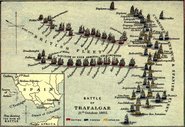To go south: "To abscond, to disappear to Mexico or Texas reinforced by Native American belief that the soul journeys south after death.
The American South has long been a curiosity. Overturned after the Civil War, but never really defeated in the heart, the south is now disappearing one state at a time. All of the fringes of the south are being encroached upon by the expanses of American corporations and the rest of Americans: The Research Triangle in North Carolina has become a collection of northern settlements for American high-tech interests [see acronyms for Cary, NC]; Northern Virginia, once the leader of the antebellum south, is a suburb of Washington, DC and scarcely retains a southern identity; Murtle Beach, Hilton Head and the rest of South Carolina's beaches have become an alternative vacation spots for non-southerners; Asheville, North Carolina is becoming an alternative retirement destination for Florida; Atlanta, once the railroad hub of the Old South, is now one of several international airline hubs of America (Delta); Florida was the retirement location for New Yorkers and now ground zero for those Americans looking for new opportunities and for other northerners escaping the harsh winters. Once, just south Florida was fair game, but now even northern Florida cities such as Tallahassee and Jacksonville are fair game. Before Katrina crossed the shorelines of SE Lousiana, Mississippi and Alabama, it appeared as if the American Riviera would be the next real estate blowup. As the next generation of carpetbaggers descends upon the south, it is interesting to examine the concept of "south" that transcends national bounds and puts what we may call the "second reconstruction" into a larger context.
The English word south [Old English: "suð" ('ð' is pronounced 'th') ] itself comes not from latin but rather curiously from Nordic through a Proto-German word (sunthaz) meaning "in the south" with a similar root to sunnun, "a place in the sun". This is possibly because the south side of a street would typically receive more sunlight on their entrances than those facing them on the other side. While the root definition of south rooted in the sun may not be eye-popping excitement, it is atleast interesting that the origin of all the western romance languages for the word "south" come from the Germanic base rather than the latin. The latin word for "south" (L. australis) appears in two examples I can think of in modern language in the form of the nation states, Australia and Austria. Both of these names are interesting for separate reasons. Austria's name is really from the German "österreich" meaning "eastern empire" and although superficially it could have mean "southern land", it has no relation to a latin origin. Australia, on the other hand, was named Terra Australis (16th c.) or "southern land". However, just to confuse the etymology of Australia further, on May 14, 1606, Pedro Fernandes de Queiros landed at Vanuatu and claimed possession of the lands to the south pole (he assumed the land continued to the south pole) for the Spanish monarchy. He named the lands Austrialía del Espíritu Santo after the House of Austria for which in Spain, the Hapsburgs were known. It seems although Austria was the original basis for the nation's name, its transition to the southern land was a result of the Spanish spelling for Austria (from österreich)! After all that, both prominent hopefuls of latin stems, disappoint. It is this German notion of South which prevails in western Europe and dutifully the Italian, Spanish and French languages take note.
The US does not have a monopoly on cultural disparities between northern and southern, worker and peasant, and wealthy and poor. North can be characterized as being urban, cultured and industrialized while south can be described as being provincial, rural and backward. Of course these descriptions have everything to do with where one may be from as I could just as easily described north as being unfriendly, filthy and greedy and south as being quite the opposite; warm, welcoming and generous. With these descriptions, the country, in this case being the US, can be replaced with many nations and places but here, specifically two. Italy provides an interesting parralel to the US in that instead of a civil war, it was unification that was divisive. France, is more of a reflection of an urban-rural conflict but the differences in dialects and at one time, language, mirror a narrowing gap in culture that is now merging. Paris will always be Paris, and likewise for the provinces, but the difference has been substantiated in recent years by location rather than culture.
Italy certainly has a marvelous history of empire and enlightenment. Ancient Roman ingenuity and Renaissance creativity and discovery, propelled Italians to the forefront of technology and learning. After, regions were governed by stagnating municipalities, and Italy remained fragmented. In the 19th century, the cities of northern Italy, dreamed of tying together all of these city-states under one Italian flag and stepping on to the political and economic scene of Europe's industrializing nations. There was only one problem to that plan of unification: All of Italy's regions were somewhat different, reflected by each region’s distinct dialect (sometimes a different language entirely) and local customs, which were especially transparent with culinary cultivations and local varietals of Vitis vinifera. Thus, we have alla bolognese or alla toscana when regarding regional food styles and Nebbiolo, Sangiovese and Montepulciano to name a few varietals of grape. These distinctions took a long time to develop and then were then instantly thrown together. Unification, led by wealthy liberals of the northern cities, delineated the clear differences of these regions but particularly the north and south, between the royal Piedmontese in the north and the impoverished Sicilians to the south. This was frequently mean-spirited as providing a contrast for how modern the north was compared to the backward south. In 1860, A general from the north, reporting on the conditions of the south to Count Cavour in Piedmont wrote, "This is not Italy. This is Africa!".3 By unifying Italy, both the north and south did not become closer in culture and politics, instead, the process "accentuated their differences".
"Massimo d'Azeglio [one of Cavour's ministers, following Italian unification]: “…having created Italy, all that remained was to create Italians."
With the many different regions and cultures spread throughout this new state of Italy, many speaking mutual imcomprehensible dialects of "Italian", eating different foods, and each celebrating its own regional and local customs, it was not clear what was meant by "Italian". This concept is lost on the world but not to Italians. This is apparent in Italian food. If traveling abroad to America for example, the majority of Italians would not consider most Italian-American restaurants to be Italian food, rather they would consider it International. This is because the menu comprised of many different national styles, Tuscan, Neapolitan, Sicilian etc. Food and Language are two of the many differences that pull Italians apart.
"L’Europe finit à Naples." (Europe ends at Naples) Il Mezzogiorno
The south of Italy served the north as an example of how far advanced (northern) Italy had become from their agrarian past. The world had shifted from the Mediterranean to Central and Northern Europe. In the past, conquest and conduct had tended to face southwards, positioning Rome and Naples with vast importance. While the scientific enlightenment and industrial revolution promoting Eurocentrism and nationalism, Italians grabbed all principalities together, used Rome as a swivel and repositioned itself facing north. No longer was Italy's wealth determined by its contact with the Orient, it's toehold in Europe would carry on the torch. However, even after the unification in 1860, the south was left woefully behind and the "Southern Question" developed as a result. Rather than a question, the situation is more problematic and painful than mere inquiry. Two-thirds of all poor Italian families are in the south. Of the 20.7 million people (36.1% of Italians) living in southern Italy, 7.3 million (35.4%) are poor, living on less than €521 per month. Some 4.6 million of these people (63.3%) are extremely poor, living on less than €435 per month. If southern Italy were independent of northern Italy, it would have the highest poverty rate in Europe. Healthcare is suffering as a result. Four times the average new-born death occurs in southern Italy. Those in need of medical treatment frequently travel north for what are perceived as better quality facilities, even though medical treatment in Italy is free. Italy’s National Health Service (NHS) ranks second on the World Health Report’s best health care systems, but also ranks first in dissatisfaction among Italians. Predictably, only 19% of Sicilians were satisfied with the NHS.
France and Occitania (Lingua d'oc)
France could not be a better state to describe a cultural shift between the primate city of Paris, and the rest of France, but especially a shift to that of southern France. There are many contrasts of Paris in the north with the provinces of the south. And as we can see from the case of Italy, there can be no more appropriate indicator than languages to determine cultural borders. Up until the turn of the century (19-20th c.), people in southern France still spoke a Gallic dialect different from that of the north. They spoke a regional blend of lingua d'oc or "language of yes" (from the word for "yes" in the south, oc) and modern French, which was based from lingua d'oïl (from the word for "yes", in this case oui). From this language bears the name of a great portion of southern France, Occitania. We also get the province Languedoc-Roussilon, formerly the territory of a county independent from the French kings. Already in the names of these regions language becomes a disparity. Gradually, the French bridged that gap and because of a strong central government and sound communication with its provinces, the influence of Paris swept across the country.
Provence
Named by conquering Romans, nostra provincia, our conquered land, because it was the first province outside of the Italian peninsula, modern Provence in southern France retained its unique seaside rural identity through invasion after conquest in the wake of Roman rule up until the second half of the 20th century. The blend of poor to mediocre soils could not sustain large populations until technological innovation reduced the need for farm labor and the land became suited for a relatively novel human activity: travel and leisure. With less than 30 days of rainfall per year, and mild winter temperatures, Provence has benefitted with ideal conditions for vacationing. However, those tied to the land through agriculture have not. Recently, housing construction along the Mediterranean coast from Provence to Languedoc-Roussilon has increased dramatically, but somehow I don’t believe that it is Provençal families that are lining up to buy the beachfront condos and coastal villas. Long been known for its small medieval towns, slow pace of life, and agricultural fields, Provence has been besieged (again) by developers looking to escape the over-hyped, excessively-wealthy pleasure playgrounds of the French Riviera cities such as Nice and Cannes. Within the last decade an artificial coastline has replaced the old natural one with less than a raised brow.
Efficient water-delivery systems, rapid transport of goods and services, and telecommunications and the internet have allowed human settlement outside of these traditionally restricting limitations. The Romans conquered water-delivery systems in their great stone aqueducts. Perhaps no better example exists than the Pond du gard, a massive three-tiered stone aqueduct bridging the River Gardon to supply nearby Nimes in the modern region of Languedoc-Roussilon. Rapid transport of goods and services continues to be improved upon with every technological innovation. Starting with water transport and the wheel, to the railroad and the automobile, and finally, the aeroplane, goods can be sent nearly everywhere on the planet. Rapid transport has allowed goods and services to spread but it is the internet and phone lines which has allowed instant connectivity to the world. This means work can be done from anywhere wired. It is not necessary any longer for an Italian to do business in Torino when one can enjoy the sun of Sicily or to be in grey Paris in the crisp winter when in France one can enjoy the mild temperatures of Aix or Nice. The same questions can be asked of the northern US. Why north when there is south?
With all the talk of global warming so prevalent in summer months harping on every record high temperature (and for good reason) it is easy to forget the north gets cold and I mean very cold. This winter took some time to get going, but now, the frigid air has hit us full force. For older Americans living in the north, just one harsh winter stands in the way of their departure for a warmer climate down south. For businesses and factories, the south was out of the question because of its incapacitating summers. However, innovations in air conditioning and with resentment ebbing every year since the civil war ended two centuries ago, the south is ripe for invasion again.
What does it mean for the residents of these “southern” regions when there is a flux of people migrating and immigrating to their towns and communities from other regions? One thing is for sure: Local customs and traditions are gradually erased as change is necessary for advancement. Old neighborhoods will be destroyed for new ones and small buildings will be replaced by bigger ones. Roads will be widened for more parking and some will become two lanes. Strip mall development will suck the old town’s life blood dry and people will be drawn to mega Walmarts and McDonalds rather than the local appliance stores and restaurants. Wait a second, this has already happened in almost every town in America. So much so, that most towns are not distinguished by any pertinent landmark or square, just by similar parking lot after parking lot. Each town loses its identity by welcoming in these outside influences.
For good or bad, while globalization flattens the world as Thomas Friedman writes, nationalization, if you will, flattens the barriers from each state creating intense forces that hasten the melting pot. The local flavors are diminished. Culture and custom are lost. No longer can celebrate holidays of local importance because corporations are run on a national schedule and don’t partake in regional holidays. History is dismissed and we all learn to march to one drum and tap to one beat. And with the change, a new culture and society is bred more apt to be better equipped to deal with the daunting change of pace that the modern world not only offers, but forces upon us. There is no time to lament. Capitalism has chosen the paths we must take and the survival of each society is dependent on how quickly and successfully they are to adapt to these changes. The Riviera will continue becoming developed and the old ways of locals unchanged for thousands of years will finally be forced, not at gunpoint, but by fiber optics, to either adapt or move away. There will be a time when the Mezzogiorno and Sicily will enter the 21st century because of high-speed internet, not high-speed trains. These changes are almost inevitable because the cheaper land and labor costs will allow them to compete with the steep costs of doing business in European markets. There is only so much stereotype and discrimination can disrupt economy.
In large measure this transition has happened. America has already seen a substantial change to the south. The research triangle in North Carolina contains the highest number of Ph.D's per capita in the US and is the biggest research park in the world. Cummings Research Park in Huntsville, AL is 3rd in Ph.D's and the world's fourth largest research park. Parts of the south boast some of the lowest unemployment rates in the country. Automobile manufacturing from Mercedes and BMW have located factories in the south. Corporations have relocated their corporate offices to the south. Surprisingly, Alabama ranks 21st nationally with the number of corporate headquarters in the state.
But with all this attention on the south, be it in Europe or the US, there has been things that have not changed. The growth in the south stands for opportunity. And in opportunity lies redemption. Going south has meant now more than ever, a place to disappear and begin again.
http://www.etymonline.com/index.php?search=south&searchmode=none&p=0 http://en.wikipedia.org/wiki/Australia
http://en.wikipedia.org/wiki/Italy#Geography http://www.ucpress.edu/books/pages/9195/9195.intro.html http://ressources.ciheam.org/om/pdf/a15/92605078.pdf http://www.iht.com/articles/2000/09/15/trprov.t.php http://www.pubmedcentral.nih.gov/articlerender.fcgi?artid=1188255
Eurostat. The social situation in the European Union. 2004 http://reports.eea.europa.eu/eea_report_2006_6/en/eea_report_6_2006.pdf http://en.wikipedia.org/wiki/Southern_United_States
11 years ago








No comments:
Post a Comment